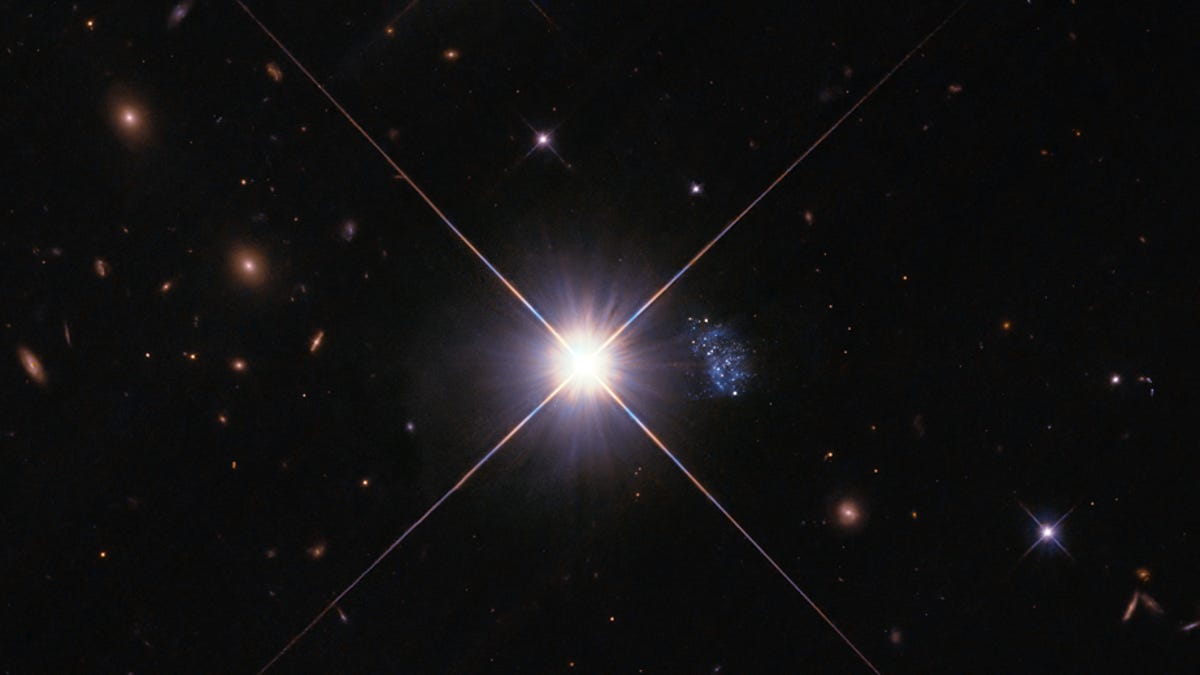NASA Spots Dwarf Galaxy 'Peekaboo,' a Time Machine to the Young Universe
The primordial cluster is in our neighborhood, cosmically speaking, but looks more like something from the dawn of time.

Tiny galaxy HIPASS J1131–31 (also known as "Peekaboo") peeks out from behind the glare of star TYC 7215-199-1, a Milky Way star positioned between Hubble and the galaxy. One hundred years ago, this fast-moving foreground star would have appeared directly in the line of sight, and the galaxy wouldn't have been detectable at all.
NASA's Hubble Space Telescope has emerged victorious in a cosmic game of hide-and-seek with an odd dwarf galaxy.
Astronomers say they've discovered a small galaxy that was largely obscured by the bright light of a star in the foreground, but now is becoming more visible as that fast-moving star has shifted its position in recent decades. They've appropriately dubbed the galaxy "Peekaboo." And it turns out to be an unlikely portal back to what galaxies were like in the earliest eons of the universe.
Peekaboo is only 20 million light-years away, which is pretty close to us for a galaxy, but it has the characteristics of a far more primordial and simple galaxy. Specifically, it's what scientists call "extremely metal poor," which means it is made largely of hydrogen and helium and lacking the heavier elements that make up our world and life itself, such as carbon, oxygen and iron.
The earliest galaxies that formed not long after the Big Bang are thought to have been extremely metal poor, but most such galaxies are billions of light-years away. Peekaboo is just around the corner, comparatively, and surrounded by galaxies like our own that are far more metal-rich.
"Uncovering the Peekaboo Galaxy is like discovering a direct window into the past, allowing us to study its extreme environment and stars at a level of detail that is inaccessible in the distant, early universe," Space Telescope Science Institute astronomer Gagandeep Anand, co-author of a new study on Peekaboo, said in a statement.
The study will be published in an upcoming issue of Monthly Notices of the Royal Astronomical Society.
Peekaboo has shown up in previous astronomical observations over 20 years ago as a region of cold hydrogen, but later observations suggested there was actually a compact galaxy hiding behind the star TYC 7215-199-1. Finally, Hubble was able to zoom in on 60 stars within the galaxy. Hubble's observations combined with metallicity data from the Southern African Large Telescope, revealed Peekaboo to be a true outlier.
"At first we did not realize how special this little galaxy is," added co-author Bärbel Koribalski, an astronomer at Australia's national science agency CSIRO. "Now with combined data from the Hubble Space Telescope, the Southern African Large Telescope (SALT), and others, we know that the Peekaboo Galaxy is one of the most metal-poor galaxies ever detected."
Peekaboo is akin to having something like a museum of the dawn of time located just down the street, and Anand says it's likely to be the subject of much study in years to come.
"Due to Peekaboo's proximity to us, we can conduct detailed observations, opening up possibilities of seeing an environment resembling the early universe in unprecedented detail."

